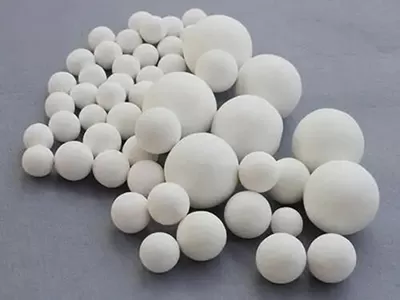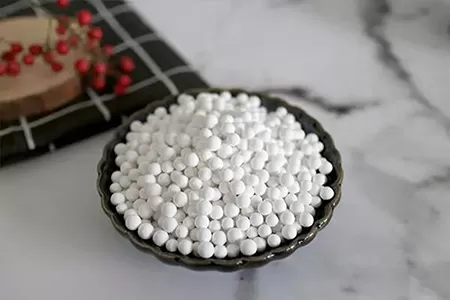Ceramic balls are made from various raw materials, primarily including alumina, zirconia, silicon carbide, and silicon nitride, with additives like binders and sintering aids to enhance their properties during manufacturing. The choice of raw materials directly determines the ceramic balls’ hardness, toughness, and resistance to heat or corrosion, making material selection a key step in their production.

Alumina ceramic balls rely on aluminum oxide (Al₂O₃) as their core raw material. This powder, often derived from bauxite through refining processes, is available in different purity levels—from 85% to 99% alumina content. Higher purity powders, such as 99% alumina, produce balls with superior hardness and wear resistance, suitable for high-precision applications. Lower purity grades may include small amounts of silica (SiO₂) or magnesia (MgO), which act as sintering aids to reduce production temperatures and improve densification. These additives help bond alumina particles during sintering, enhancing structural integrity without significantly compromising performance.
Zirconia ceramic balls are crafted from zirconium dioxide (ZrO₂) powder, typically obtained from zircon sand. Pure zirconia undergoes phase transformations at high temperatures, which can cause cracking, so stabilizers are added to prevent this. Common stabilizers include yttrium oxide (Y₂O₃), calcium oxide (CaO), or cerium oxide (CeO₂), mixed with zirconia powder in ratios ranging from 3% to 8%. Yttria-stabilized zirconia (YSZ) is widely used, as it maintains a stable cubic structure, 赋予 the balls high toughness and impact resistance. This combination of zirconia and stabilizers makes the balls ideal for applications requiring both strength and flexibility.

Silicon carbide ceramic balls start with silicon carbide (SiC) powder, produced through reactions between silica and carbon at high temperatures. The powder is available in two forms: alpha-SiC and beta-SiC, with alpha-SiC being more stable at elevated temperatures. To aid sintering, small amounts of boron carbide (B₄C) or carbon are added as sintering aids, promoting particle bonding during high-temperature processing (around 2000°C). These additives help achieve high density in the final product, enhancing the balls’ extreme hardness and thermal conductivity, which are critical for grinding hard materials.
Silicon nitride ceramic balls are made from silicon nitride (Si₃N₄) powder, synthesized via reactions between silicon and nitrogen gas. Sintering silicon nitride requires additives like yttrium oxide (Y₂O₃) or aluminum oxide (Al₂O₃) to form a glassy phase that binds the particles, allowing densification at temperatures around 1700°C. These additives also improve the material’s fracture toughness and resistance to thermal shock, making silicon nitride balls suitable for high-temperature environments. The raw silicon nitride powder’s purity is tightly controlled, as impurities can weaken the balls’ structural stability under stress.
In addition to primary materials, binders are often used during the shaping stage to hold ceramic powders together before sintering. Organic binders like polyvinyl alcohol (PVA) are common, as they burn off during sintering without leaving residues. Water or organic solvents may also be added to form a paste-like mixture, facilitating shaping through processes like isostatic pressing or injection molding.
The quality of raw materials is paramount, as impurities can degrade the ceramic balls’ performance. For example, iron oxide contaminants in alumina powder can reduce wear resistance, while inconsistent particle sizes in zirconia powder may lead to uneven sintering. Manufacturers therefore source high-purity powders and conduct rigorous testing to ensure raw materials meet strict specifications.
In summary, ceramic balls are made from specialized powders—alumina, zirconia, silicon carbide, or silicon nitride—enhanced with sintering aids and binders. Each raw material contributes unique properties, enabling the production of ceramic balls tailored to diverse industrial needs, from grinding media to high-temperature bearings.



